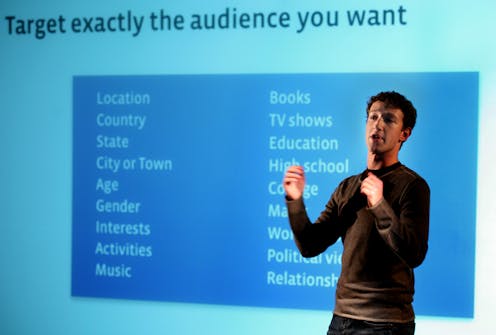Facebook's business is helping other businesses
Facebook's focus on personalizing ads has created new tools for businesses to interact with customers and to connect coworkers.

Facebook’s rise to become one of the world’s largest advertising platforms began in 2004 with US$382,000 in revenue in just its first year, serving 400,000 college students. The site displayed basic banner ads called “Flyers,” which cost between $10 and $40 a day. Many of them promoted events at Harvard University, where Facebook’s founders were based.
Three years later, after opening membership to anyone 13 and over, not just college students, the company took its first step toward what it has become famous – even notorious – for: micro-targeted advertising. It launched an ad program called “Flyers Pro,” in which advertisers could target specific ads to particular audiences based on their age, gender, home location, workplace, level of education, relationship status and other personal information.
Facebook’s approach to ads has been transformative for businesses, letting them expand their advertising options significantly. Just as the internet helped millions of people find others who shared their interests and hobbies all around the world, Facebook made it easy for businesses to advertise to large numbers of very specialized audiences. That power has created many new opportunities for businesses, as well as a multi-billion-dollar fortune for Facebook and Mark Zuckerberg, the company’s founder, CEO and chief shareholder.
Buying and selling
In 2007, the same year it began micro-targeting ads, Facebook unveiled the mobile version of its website, followed in 2010 by its standalone mobile app. Reaching people on the go has proved profitable: Mobile ads now represent 90 percent of Facebook’s ad revenue.
Also in 2007, the company started what it called “Marketplace,” an online space within Facebook for users to buy and sell goods and services with each other. It tried to exploit a particular weakness in human cognition about interruptions in trains of thought. Shifting from one context to another is complex. For instance, it’s not simple to go from seeing a comment about ragged jeans on a friend’s Facebook page, to visiting Amazon and actually buying the jeans as a gift. Facebook’s Marketplace hoped to reduce that barrier, letting users see the comment and make the purchase without leaving the Facebook site.
That effort took years to catch on, but a refreshed Marketplace that launched in 2016 in the U.S., the U.K., Australia and New Zealand quickly became a promising opportunity for businesses to connect with nearby users.
Improving communications
In 2008, Facebook launched Pages, a sort of mini-website within Facebook where companies could could post and users could comment and even subscribe to notifications when the business posted anything new. Our research found that active Page owners could increase their connections and interactions with their fans.
In 2016, the company introduced a radical expansion, letting Facebook Page owners create chatbots – automated programs that could response to users’ inquiries. For instance, a flower shop could have a chatbot auto-respond to every customer wondering what hours the business is open, or how much a dozen roses cost. That would get clients faster answers and save work on the part of the flower shop staff.
Chatbots can also be useful within businesses. For our research, we created a chatbot on Facebook that lets managers automate the task of assigning work to employees and tracking their progress. We found it reduces conflict because the supervisor isn’t the one pressuring the worker to finish up. And it helped staff feel more comfortable communicating their own needs, such as asking for extra time to accomplish a particular task.
Other Facebook services for business include what is essentially a private social network aimed at businesses, in which coworkers can collaborate. Employees, who are often familiar with how Facebook works in their personal lives, can use the same interface and tools to connect and collaborate with each other at work.
What’s next?
Facebook’s main guiding principle is that people want to see ads tailored to their interests. As a result, it has guided its users’ interactions in ways that help relevant businesses make sales. In a sense, Facebook is offering a new type of mall, which does indeed help connect buyers and sellers.
However, as details continue to emerge about how Facebook determines who is interested in what topics and how controversial advertisers can target and even possibly manipulate people based on their interests, the company might consider how much data it wants to collect. Customers, at least, seem to feel there should be a privacy barrier, even if it results in less ad personalization.
One of the Ph.D. students of Dr. Savage recently won the Facebook Emerging Scholar Fellowship.
Eber Betanzos receives funding from "Consejo Nacional de Ciencia y Tecnología CONACYT" (the Mexican National Council of Science and Technology) as an affiliate researcher at the Independent School of Law (ELD).
Carlos Toxtli does not work for, consult, own shares in or receive funding from any company or organization that would benefit from this article, and has disclosed no relevant affiliations beyond their academic appointment.
Read These Next
As DOJ begins to release Epstein files, his many victims deserve more attention than the powerful me
Powerful men connected to Jeffrey Epstein are named, dissected and speculated about. The survivors,…
How to reduce gift-giving stress with your kids – a child psychologist’s tips for making magic and a
Depending on family circumstances and a child’s personality type, gift giving runs the gamut of fun…
People are getting their news from AI – and it’s altering their views
Even when information is factually accurate, how it’s presented can introduce subtle biases. As large…






